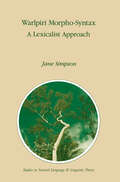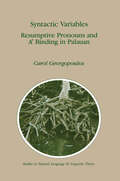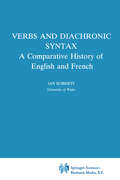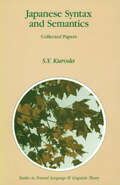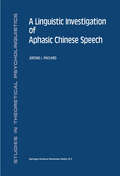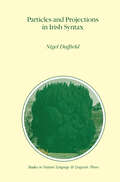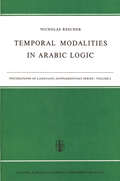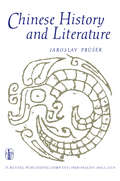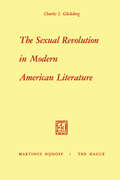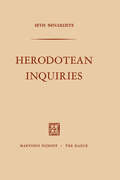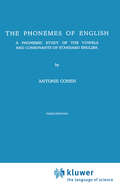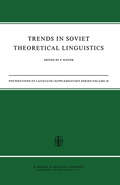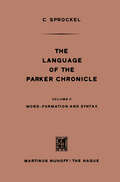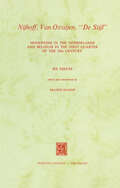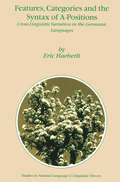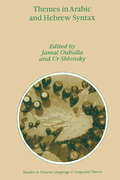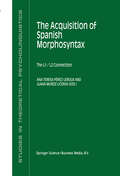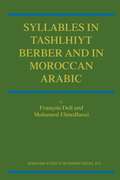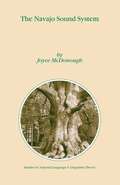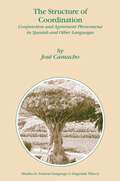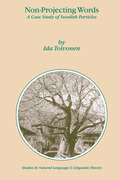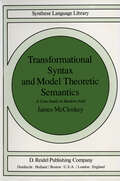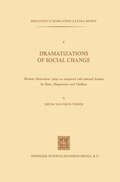- Table View
- List View
Warlpiri Morpho-Syntax: A Lexicalist Approach (Studies in Natural Language and Linguistic Theory #23)
by J. SimpsonSyntactic Variables: Resumptive Pronouns and A′ Binding in Palauan (Studies in Natural Language and Linguistic Theory #24)
by C. GeorgopoulosThis book represents the culmination of an extended period of field work on the Palauan language, carried out while I was a graduate student at the University of California at San Diego. The book was born as a short term paper written in 1982; from a forgettable infancy, that paper grew and grew, reaching the age of majority in my dissertation at the end of 1985. Some of its offspring have gone off on their own, as indepen dent papers, as course materials, or as thoughts that have not yet com pletely materialized. Some have been disowned. The full adulthood of this study of Palauan is realized in the present book. Virtually every section of the dissertation has been rewritten, updated, or otherwise (I hope) improved. Where the dissertation was still struggling with various problems, the book has found solutions. The aim of the book remains, however, to give broad coverage of Palauan, with emphasis on A' binding, rather than to focus narrowly on a few highly specific theoretical issues. I hope to have achieved a balance between presenting the language clearly and nonprejudicially, and deal ing with various of its properties in current theoretical terms. If I have, the book should prove to be a resource for further typological study of the phenomena it describes.
Verbs and Diachronic Syntax: A Comparative History of English and French (Studies in Natural Language and Linguistic Theory #28)
by I.G. RobertsThis book combines several strands of my work, both individually and in collaboration with various people, over the last couple of years. To a very large extent, I have been inspired by the many talks, classes, appointments and other interactions that took place in the exciting intellectual environ ment that grew up among the linguists working in Geneva in the period 1989-90. It is impossible to mention by name everyone who influenced the devel opment of this material, but I'd particularly like to thank the students in my class 'linguistique diachronique' during that period, who had to suffer through preliminary versions of much of this book, and often seemed to understand what I was getting at better than I did. Luigi Rizzi did more than anyone else to create the unique atmosphere here in the last couple of years, and so he deserves our gratitude for that; he was also my collaborator on the synchronic work on French inversion that inspired much of this book; he also read the whole manuscript in draft form and gave detailed comments; he is also, as anyone working in current comparative syntax knows, a wellspring of knowledge, ideas and inspiration. Maria-Teresa Guasti also read the entire manuscript and gave me invaluable comments. Sten Vikner was a great help, for much more than just Danish data. Special thanks also to Adriana Belletti, Anna Cardinaletti, Liliane Haegeman and Cecilia Poletto.
Japanese Syntax and Semantics: Collected Papers (Studies in Natural Language and Linguistic Theory #27)
by S.-Y. Kuroda1. Two main themes connect the papers on Japanese syntax collected in this volume: movements of noun phrases and case marking, although each in turn relates to other issues in syntax and semantics. These two themes can be traced back to my 1965 MIT dissertation. The problem of the so-called topic marker wa is a perennial problem in Japanese linguistics. I devoted Chapter 2 of my dissertation to the problem of wa. My primary concern there was transformational genera tive syntax. I was interested in the light that Chomsky'S new theory could shed on the understanding of Japanese sentence structure. I generalized the problem of deriving wa-phrases to the problem of deriving phrases accompanied by the quantifier-like particles mo, demo, sae as well as wa. These particles, mo, demo and sae may roughly be equated with a/so, or something like it and even, respectively, and are grouped together with wa under the name of huku-zyosi as a subcategory of particles in Kokugogaku, Japanese scholarship on Japanese grammar. This taxonomy itself is a straightforward consequence of distributional analysis, and does not require the mechanisms of transformational grammar. My transformational analysis of wa, and by extension, that of the other huku zyosi, consisted in formally relating the function of the post-nominal use of wa to that of the post-predicative use by means of what I called an attachment transformation.
A Linguistic Investigation of Aphasic Chinese Speech (Studies in Theoretical Psycholinguistics #18)
by J. PackardA Linguistic Investigation of Aphasic Chinese Speech is the first detailed linguistic analysis of a large body of aphasic Chinese natural speech data. This work describes how the major aphasia syndromes are manifest in Chinese, a language which differs significantly from languages upon which traditional aphasia theory is based. Following the Chinese data, a new explanation for the major aphasia syndromes is offered based on the cognitive science modularity hypothesis. The theory posits that Broca's aphasia is the result of computational deficits that occur within linguistic components, while Wernicke's aphasia is the result of deficits that occur in the transfer of information between components. It is demonstrated how the fluent and non-fluent characteristics of the major aphasia syndromes follow directly from the properties of cognitive modules. Detailed linguistic descriptions of Broca's and Wernicke's aphasia in Chinese are provided, including a summary of diagnostics of aphasia type. The complete corpora of four aphasic Chinese speakers, including interlinear and free translations, are presented in an Appendix.
Particles and Projections in Irish Syntax (Studies in Natural Language and Linguistic Theory #32)
by N. DuffieldTemporal Modalities in Arabic Logic (Foundations of Language Supplementary Series #2)
by N. RescherThe aim of this monograph is to expound the conceptions of temporalized modality at issue in various Arabic logical texts. I claim to have been able to make good logical sense of doctrines of which even the later Arab logicians themselves came to despair. In the process, a substantially new area of the history of logic has come into a clear view. I am indebted to Anne Cross (Mrs. Michael) Pelon and especially Mr. Bas van Fraassen for assistance in the research. Miss Dorothy Henle merits my thanks for preparing the difficult typescript for the printer and helping to see the book through the press. Also, I am grateful to the Editors of Foun dations of Language for inviting inclusion of the monograph in the Supple mentary Series of the journal. The present work is part of a series of studies of Arabic contributions to logic supported by research grants from the National Science Foundation. It affords me much pleasure to record my sincere thanks for this assistance.
Chinese History and Literature: Collection of Studies
by J. PrusekThe studies contained in this volume arose over the last thirty years. Originally the range of the materials I intended to include in my selection was very much wider. Publishing difficulties, however, have obliged me to curtail them to something less than half the planned content. At first I intended to include all the studies I supposed might be of interest to readers and represent contributi ons still of some significance for research in this domain of Oriental scholarship. When the necessity arose to limit the contents I gave preference to the standpoint of thematic completeness rather than to what would be of interest to the general reader. Thus in this volume I have confined myself to two them atic fields only-Old Chinese literature and studies dealing with mediaeval storytellers' productions-hua-pen. I have excluded the whole complex of historical studies and all studies relating to the new literature. I am now preparing, on the principal historical theme on which I was engaged already in the period of my studies in Prague under Prof. J. Bidlo, and then in 1928 till 1930, with Prof. B. Karlgren in Sweden and Prof. G. Haloun in Halle, in Germany, a more compendious study in which I hope to sum up the results of my research, and I also intend to publish a volume of selected studies dealing with the New Chinese literature at some later date.
The Sexual Revolution in Modern American Literature
by I. Glicksberg1. The Dialectic of the Sex-Motif in Literature Sex is a function of culture; in literature today it plays only a small though aggressively righteous part. Nature, long held in bondage, periodically breaks out in revolt, but its victory is never complete. In every society, prim itive as well as modem, the sexual instinct is for good or evil always subject to some measure of regulation and restraint. In literature, where the battle between love and sex, spirit and flesh, is fought out in terms of symbolic action, the writers support their cause, for or against sexual freedom, with varying degrees of evangelical ardor and outspokenness. On this issue there is no unanimity for the simple reason that American culture is not unified in its beliefs concerning the nature of man. The central conflict between instinctual needs and the claims of the ideal, between physical desire and the inner check, between Dionysus and Christ, goes on all the time. Sublimation is the cultural process whereby sexual energy is deflected from its biological source and diverted into spiritually "higher" and socially more useful channels. But sublimation is for most men hard to achieve. As civilization grows more complex, the individual is exposed to a series of increasingly severe moral strains. Pitted against Nature while subject to its laws, he must hence forth be governed in his behavior by inner as well as outer controls.
Herodotean Inquiries
by S. BenardeteHerodotus has so often been called, since ancient times, the father of history that this title has blinded us to the question: Was the father of history an historian? Everyone knows that the Greek word from which 'history' is derived always means inquiry in Herodotus. His so-called Histories are in quiries, and by that name I have preferred to call them. His inquiries partly result in the presentation of events that are now called 'historical'; but other parts of his inquiry would now belong to the province of the anthro pologist or geographer. Herodotus does not recognize these fields as distinct; they all belong equally to the subject of his inquiry, but it is not self-evident what he understands to be his subject: the notorious difficulties in the proemium are enough to indicate this. If his work presents us with so strange a mixture of different fields, we are entitled to ask: Did Herodotus under stand even its historical element as we understand it? Without any proof everyone, as far as I am aware, who has studied him has assumed this to be so.
The Phonemes of English: A Phonemic Study of the Vowels and Consonants of Standard English
by A. CohenI gladly take this opportunity to convey my heartfelt thanks to those who have guided me on my way as an undergraduate and who have enabled me through their teachings and friendly advice to proceed to preparing for this doctorate thesis. I should like first of all to thank Prof. C. L. Wrenn, M. A., now of Pembroke College, Oxford, who has always been extremely helpful to me and who was generous enough to admit me to the Honours English Course at King's College, University of London. After moving to Oxford he still found time to show interest in my progress and on more than one occasion helped me with his wise counsels. I am also extremely grateful to his successor at King's College, Prof. G .. Bullough, M. A., who likewhise helped me whenever he could. I feel greatly indebted to Prof. D. Jones, M. A., Dr. Phil., who at the time was Professor of Phonetics at University College, London, and from whose lectures and methods of expression I greatly benefited. I am particularly thankful for the kindness shown to me by the staffs of the English department of King's College and of the Phonetics department of University College for the excellent tuition I received from them and for making me feel completely at home among my English fellow students. I am happy to acknowledge the generosity with which Prof. Dr. P. N. U.
Trends in Soviet Theoretical Linguistics (Foundations of Language Supplementary Series #18)
by F. Kiefero. Theoretical linguistics is a term not very often used in Soviet Linguistics. The terms 'structural linguistics', 'mathematical linguistics', 'applied lin guistics' (which, incidentally, has another meaning here than in other parts of the world) all may cover theoretical work in linguistics. In older days serious theoretical work was done under the heading 'machine translation'. Very often the need for a special term for theoretically oriented studies in linguistics does not even arise. Does this mean that there is no real theoretical linguistics in the Soviet Union? This would be, of course, a completely false conclusion. Some lin guists tend to identify theoretical linguistics with generative grammar. Though it might be true - and I am myself very much inclined to subscribe to this view - that generative grammar has been the most fruitful linguistic theory up to now, this does not justify, however, the above identification. Incidentally, as we shall see later on, generative grammar has not been left unnoticed in the Soviet Union either. There are different trends within theo retical linguistics, one of which is generative grammar. While generative grammar (though one can worry about the content of this notion for many. internal and external reasons) seems to be the mean theoretical trend in the United States and in Western Europe, it represents only one of the main trends in Soviet linguistics.
The Language of the Parker Chronicle: Volume II Word-Formation and Syntax
by C. SprockelThe reception accorded to the first volume of this book has en couraged me to redeem my promise to write a sequel on the word formation and syntax of the same text. (It is hoped that my edition of the text which forms the basis of these studies will appear in due course. ) Since these aspects of Old English have been virtually ig nored by scholars so far. I do not think I need offer any apology for making some contribution to such scanty information about them as is currently at our disposal. Some friends who urged me to undertake this task added the warning that I would find myself treading on much more dangerous ground. Having gone through the experience. I must now admit that syntactic analysis presents much more intractable problems than phonology. Some information about the method followed in this treatise is to be found in the introductions to the two parts. As far as possi ble I have used conventional terms. but not without explaining in what sense they are to be understood in this work. I admit that there is plenty of room for disagreement with my conclusions; but they are conclusions which I arrived at after giving much thought to the problems in each individual case. Even in cases where the reader finds he must agree to differ. I hope he will find the argu ments stimulating.
Nijhoff, Van Ostaijen, "De Stijl": Modernism in the Netherlands and Belgium in the First Quarter of the 20th Century. Six Essays
by F. BulhofFRANCIS BULHOF "What was Modernism?" That is the title of an address delivered in June of 1960 by the eminent comparatist Harry Levin at Queen's University in King ston, Ontario.1 Apparently, more than a decade ago, in the eyes of this per ceptive analyst of literature and the arts, the modernist movement had become a thing of the past. Having acquired full citizenship in the republic of letters, modernism had outlived itself. The title of Harry Levin's lecture bears an obvious resemblance to that of Fritz Martini's book-length essay Was war Expressionismus?,2 which dealt exclusively with the German variant of the expressionist movement. In the case of German expressionism there is much dispute concerning the precise moment of its decline and fall, but the political conditions provide at least a crucial dividing line in the year 1933. The end of modernism, however, a far more comprehensive movement which was not just limited to one country, is not so easy to determine. And there is also still much discussion about its roots.
Features, Categories and the Syntax of A-Positions: Cross-Linguistic Variation in the Germanic Languages (Studies in Natural Language and Linguistic Theory #54)
by E. HaeberliThis book investigates various aspects of the distribution of nominal arguments, and in particular the cross-linguistic variation that can be found among the Germanic languages in this domain of the syntax. The empirical topics discussed include variable vs. fixed argument order, the distribution of subjects with respect to adjuncts, expletive constructions, and oblique subjecthood. These are analyzed within a theoretical framework which is based on the Minimalist Program.
From Syntax to Discourse: Pronominal Clitics, Null Subjects and Infinitives in Child Language (Studies in Theoretical Psycholinguistics #29)
by C. Hamannclaim is that such morphological processes can be learnt without symbolization and innate knowledge. See Rumelhart and McClelland (1986) for the original model of past tense acquisition, Plunkett and Marchman (1993), Nakisa, Plunkett and Hahn (1996) and Elman et al. (1996) for developments and extensions to other morphological processes, and Marcus et al. (1992) and Pinker and Prince (1988) for criticism. One line of investigation supporting the view of language as a genetic endowment is closely linked to traditional research on language acquisition and argues as follows: If language is innate there must be phenomena that should be accessible from birth in one form or the other. Thus it is clear that the language of children, especially young children and preferably babies should be investigated. As babies unfortunately don't talk, the abilities that are available from birth must be established in ways different from the usual linguistic analysis. Psycholinguistic research of the last few years has shown that at the age of 4 and 8 months and even during their first week of life children already have important language skills. From the fourth day, infants distinguish their mother tongue from other languages. From the first months children prefer the sound of speech to 'other noise'. At the age of 4 months, infants prefer pauses at syntactic boundaries to random pauses.
Themes in Arabic and Hebrew Syntax (Studies in Natural Language and Linguistic Theory #53)
by JAMAL OUHALLA and UR SHLONSKYThe aim of this enterprise is to assemble together in one volume works on various syntactic aspects of Arabic and Hebrew, in the hope that it will spur further comparative work within the Semitic family at the level of richness achieved in other language families such as Germanic and Romance. Although a substantial amount of work on the syntax of Arabic and Hebrew already exists in various forms, volumes of the type we have attempted are still practically non-existent. Moreover, apart from some notable exceptions, existing studies rarely take a systematic within-family comparative stance towards the phenomena they discuss, although cross-references between studies on Arabic and Hebrew are not uncommon. Obviously, we would ideally have preferred the volume to include papers on numerous other Semitic languages, including the languages of the Ethio Semitic branch as well as numerous spoken varieties of Arabic that have yet to be explored. Unfortunately, this was not possible due to circumstances beyond our control. We very much hope that the existence of this volume will make more inclusive volumes on the syntax of the Semitic languages only a matter of time.
The Acquisition of Spanish Morphosyntax: The L1/L2 Connection (Studies in Theoretical Psycholinguistics #31)
by Juana MuñozLiceras Ana TeresaPérez-LerouxRecent developments in linguistic theory, as well as the growing body of evidence from languages other than English, provide new opportunities for deeper explorations into how language is represented in the mind of learners. This collection of new empirical studies on the acquisition of Spanish morphosyntax by leading researchers in the field of language acquisition, specifically contributes to the characterization of the L1 / L2 connection in acquisition. Using L1 and L2 Spanish data from children and adults, the authors seek to address the central questions that have occupied developmental psycholinguists in the final decades of the previous century and that will no doubt continue engaging them into the present one.
Syllables In Tashlhiyt Berber And In Moroccan Arabic (International Handbooks of Linguistics #2)
by F. Dell M. ElmedlaouiThis book is intended primarily as an original contribution to the investi gation of the phonology of the two main languages spoken in Morocco. Its central topic is syllable structure. Our theoretical outlook is that of generative phonology. Most of the book deals with Tashlhiyt Berber. This language has a syllable structure with properties which are highly unusual, as seen from the vantage point of better-studied languages on which most theorizing about syllabification is based. On the one hand, complex consonant sequences are a common occurrence in the surface representations. On the other hand, syllable structure is very simple: only one distinctive feature bundle (phoneme) may occur in the onset, the nucleus or the coda. The way these two conflicting demands are reconciled is by allowing vowelless sylla bies . Any consonant may act as a syllable nucleus. When astring is syllabified, nuclear status is preferentially assigned to the segments with a higher degree of sonority than their neighbours. Consider for instance the expression below, which is a complete sentence meaning 'remove it (m) and eat it (m)': /kks=t t-ss-t=t/ [k. st. s . t:"] . k. k~t. t. s. . slt. The sentence must be pronounced voiceless throughout, as indicated by the IPA transcription between square brackets ; the syllabic parse given after the IPA transcription indicates that the sentence comprises four syllables (syllable nuclei are underlined). The differences between the dialects of Berber have to do primarily with the phonology and the lexicon.
The Navajo Sound System (Studies in Natural Language and Linguistic Theory #55)
by J.M. McDonoughThe Navajo language is spoken by the Navajo people who live in the Navajo Nation, located in Arizona and New Mexico in the southwestern United States. The Navajo language belongs to the Southern, or Apachean, branch of the Athabaskan language family. Athabaskan languages are closely related by their shared morphological structure; these languages have a productive and extensive inflectional morphology. The Northern Athabaskan languages are primarily spoken by people indigenous to the sub-artic stretches of North America. Related Apachean languages are the Athabaskan languages of the Southwest: Chiricahua, Jicarilla, White Mountain and Mescalero Apache. While many other languages, like English, have benefited from decades of research on their sound and speech systems, instrumental analyses of indigenous languages are relatively rare. There is a great deal ofwork to do before a chapter on the acoustics of Navajo comparable to the standard acoustic description of English can be produced. The kind of detailed phonetic description required, for instance, to synthesize natural sounding speech, or to provide a background for clinical studies in a language is well beyond the scope of a single study, but it is necessary to begin this greater work with a fundamental description of the sounds and supra-segmental structure of the language. Inkeeping with this, the goal of this project is to provide a baseline description of the phonetic structure of Navajo, as it is spoken on the Navajo reservation today, to provide a foundation for further work on the language.
The Structure of Coordination: Conjunction and Agreement Phenomena in Spanish and Other Languages (Studies in Natural Language and Linguistic Theory #57)
by J. CamachoThis book analyzes the structure of coordination from two perspectives: the symmetrical properties the construction imposes on its conjuncts, and how conjuncts interact with other categories outside coordination with respect to agreement and other grammatical phenomena. A substantial amount of data represented in this book are taken from varieties of Spanish. Unlike English, Spanish has a rich pattern of overt agreement between the subject and the verb, between nouns and adjectives, and also between clitics and lexical DP objects and indirect objects. Spanish agreement paradigms reveal very interesting patterns of agreement mismatch that provide important theoretical insights. Unless otherwise specified, it can be assumed that non-English examples are from Spanish. IX CHAPTER #1 INTRODUCTION Although coordination has figured more or less steadily in the Generative tradition beginning with Chornsky's (1957) Conjunction Transformation (later known as Conjunction Reduction), until recently, the two prevailing areas of research had been ellipsis (see, for example, Van Oirsouw 1987) and the semantic interpretation of conjuncts.' The internal structure of coordination was usually left unanalyzed, or assumed to be ternary branching, as in (I).
Non-Projecting Words: A Case Study of Swedish Particles (Studies in Natural Language and Linguistic Theory #58)
by I. ToivonenFocusing primarily on Swedish, a Germanic language whose particles have not previously been studied extensively, this study develops a theory of non-projecting words in which particles are morphologically independent words that do not project phrases. It identifies the violations of the basic tenets of X-bar theory and develops a formally explicit revision of X-bar theory that can accommodate the requisite "weak" projections.
Literature of the Low Countries: A Short History of Dutch Literature in the Netherlands and Belgium
by Reinder MeijerIn any definition of terms, Dutch literature must be taken to mean all literature written in Dutch, thus excluding literature in Frisian, even though Friesland is part of the Kingdom of the Netherlands, in the same way as literature in Welsh would be excluded from a history of English literature. Simi larly, literature in Afrikaans (South African Dutch) falls outside the scope of this book, as Afrikaans from the moment of its birth out of seventeenth-century Dutch grew up independently and must be regarded as a language in its own right. . Dutc:h literature, then, is the literature written in Dutch as spoken in the Kingdom of the Netherlands and the so-called Flemish part of the Kingdom of Belgium, that is the area north of the linguistic frontier which runs east-west through Belgium passing slightly south of Brussels. For the modern period this definition is clear anough, but for former times it needs some explanation. What do we mean, for example, when we use the term 'Dutch' for the medieval period? In the Middle Ages there was no standard Dutch language, and when the term 'Dutch' is used in a medieval context it is a kind of collective word indicating a number of different but closely related Frankish dialects. The most important of those were the dialects of the duchies of Limburg and Brabant, and of the counties of Flanders and Holland.
Transformational Syntax and Model Theoretic Semantics: A Case Study in Modern Irish (Studies in Linguistics and Philosophy #9)
by J. McCloskeyThis piece of work began life as a doctoral thesis written at the University of Texas between 1976 and 1978. Now after a year in Dublin it is to become a book. Of the many people in the Department of Linguistics at Texas who shaped my interests and who helped me through the writing of the thesis, I must single out Lee Baker, Lauri Karttunen, Bill Ladusaw, Sue Schmerling and Stanley Peters for special gratitude. All of them have provided specific suggestions which have improved this work, but perhaps more .importantly they provided a uniquely stimulating and harmonious environment in which to work, and a demanding set of professional standards to live up to. To Ken Hale lowe a particular debt of gratitude - for two years of encour agement and suggestions, and particularly for a set of detailed comments on an earlier version of the book which led to many changes for the better. I also thank my friends Per-Kristian Halvorsen and Elisabet Engdahl, both of whom took the trouble to provide me with detailed criticisms and comments. In Dublin I am grateful to the School of Celtic Studies of the Institute for Advanced Studies for giving me the opportunity of teaching a seminar on many of the topics covered in the book and of exposing the material to people whose knowledge of the language is unequalled. Donal 6 Baoill and Liam Breatnach have been particularly helpful.
Dramatizations of Social Change: Herman Heijermans’Plays as Compared with Selected Dramas by Ibsen, Hauptmann and Chekhov (Bibliotheca Neerlandica extra muros #5)
by Hilda van Neck YoderHerman Heijermans (1864-1924) was convinced that he lived in an "overgangs 1 tijdperk," a transitional period. As a young man in the eighteen nineties, he rejected those values and life styles which he felt belonged to the past period dominated by the bourgeoisie, and sought out situations and a profession which would attune him to the future when, he hoped, the proletariat would 2 be in power. He left the conservative business milieu of Rotterdam in 1892 and went to Amsterdam- then teeming with radical ideas. At first, Heijermans was attracted to a group of poets, de tachtigers, who were claiming to have enlivened the stale tradition of Dutch poetry by discovering language and beauty in a totally new way; but soon he felt them to be elitist. Then, in 1895, he became a member of the newly founded Dutch Social Democratic Workers Party. He alienated himself from the literary circles by claiming that art should be socialistic and by rejecting the class separation between artists and workers. He felt himself to be one with the proletariat and, through them, with "The New Life" and "The New Humanity. " Stimulated by the ongoing theater revival, which he interpreted as an attempt to challenge the bourgeois smugness and moral self-righteousness, he had started to write plays before becoming interested in the Socialist Party.
